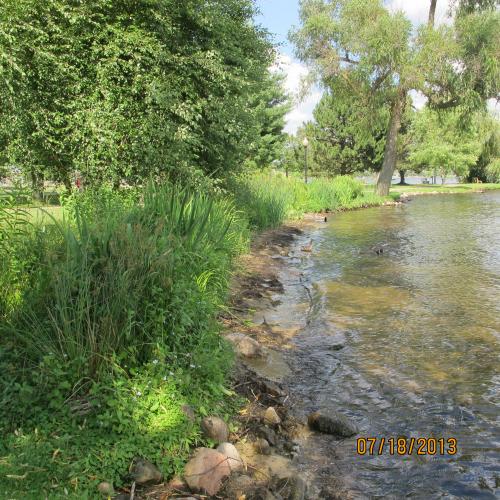Spring break-up and flooding at Cadillac Lakefront Park
Natural shoreline demonstration site weathers Lake Cadillac ice action and high water without problems.

Often, the justification for hard-scaping inland lake shorelines with rock rip rap or seawall is the fear of property damage by ice action or spring flooding. Although these phenomena can be serious threats, undisturbed shoreline and near shore areas are less likely to fall victim to these forces than traditional turf to the water’s edge. As demonstrated last spring in the City of Cadillac, restoration of a natural plant community that is adapted to these forces can be a solution to problems caused by ice break-up and flooding.
The natural shoreline demonstration site at Cadillac Lakefront Park was constructed in May 2011 as the required field component of Certified Natural Shoreline Professional – intensive certification training for waterfront contractors. With minimal maintenance, native shoreline plantings and bioengineered linear shoreline protection have transformed 100 feet of eroding lakefront into an attractive buffer strip that slows runoff, stabilizes soil and attracts songbirds and butterflies.
In the spring of 2013, the ice blew in off Lake Cadillac and piled up on the demo site. Rising waters took its place and shoreline plantings endured inundation for several weeks. Spring winds and wave action on flooded shorelines can also be an erosion concern. But the restored native wetland plant community (including Swamp Milkweed and Common Rush) is well-adapted to what the lake dished out and by early summer the site was thriving and without of trace of damage.

Photo: Summer 2013 Cadillac natural shoreline demonstration site showing no signs of damage from ice and flooding. Photo credit: Jane Herbert
When considering the advantages of a natural shoreline, the height to which many native shoreline plants can grow can be a deal-breaker for lakefront property owners. However, it is possible to achieve a careful design that allows for access to docks and swimming areas. Keep in mind a dense buffer strip of native plants can also be a deterrent to geese.
The Michigan Natural Shoreline Partnership’s Guidebook for Property Owners available through the Michigan State University Extension Bookstore is especially for lakefront homeowners. This attractive publication offers design ideas and a suggested list of native Michigan shoreline plants that can resist the ravages of spring at the water’s edge.



 Print
Print Email
Email




